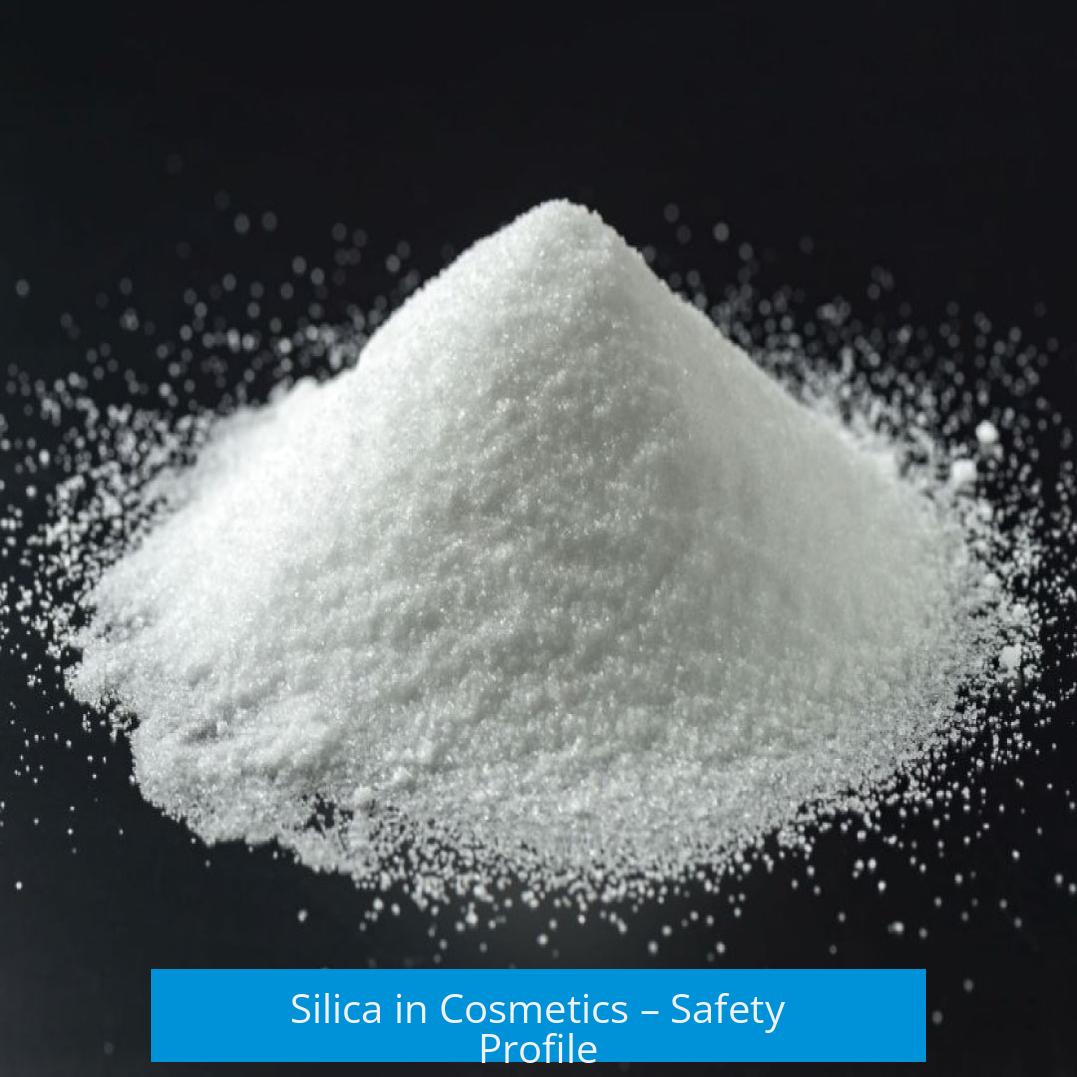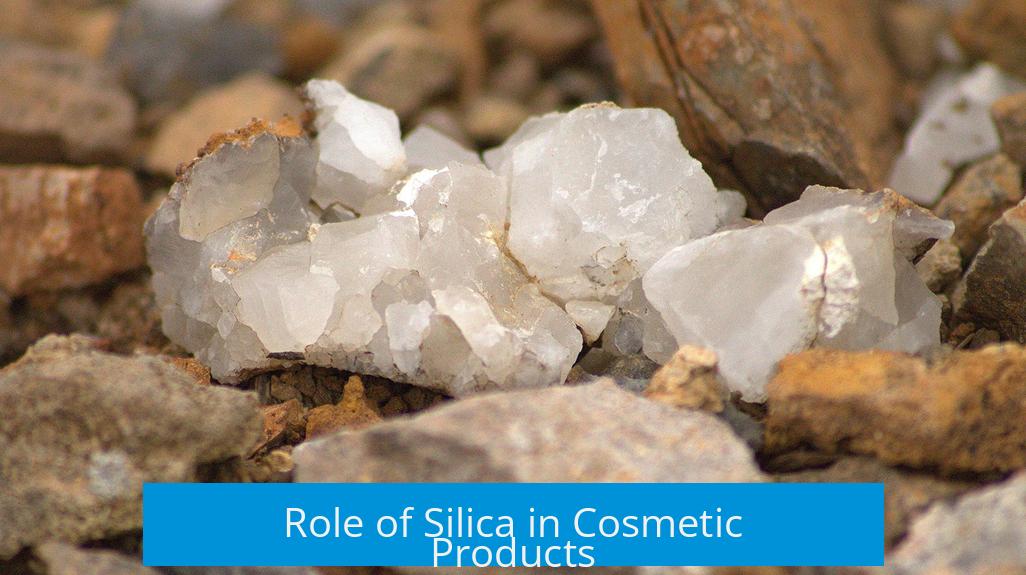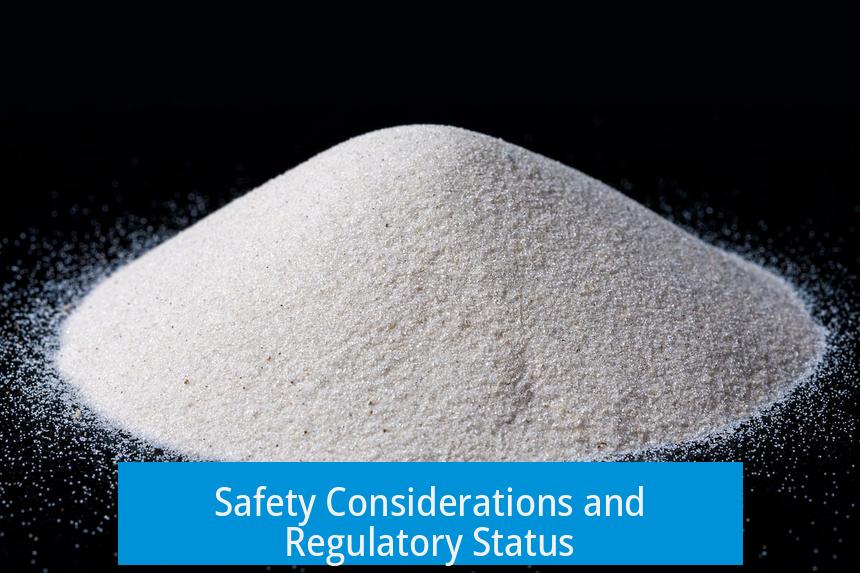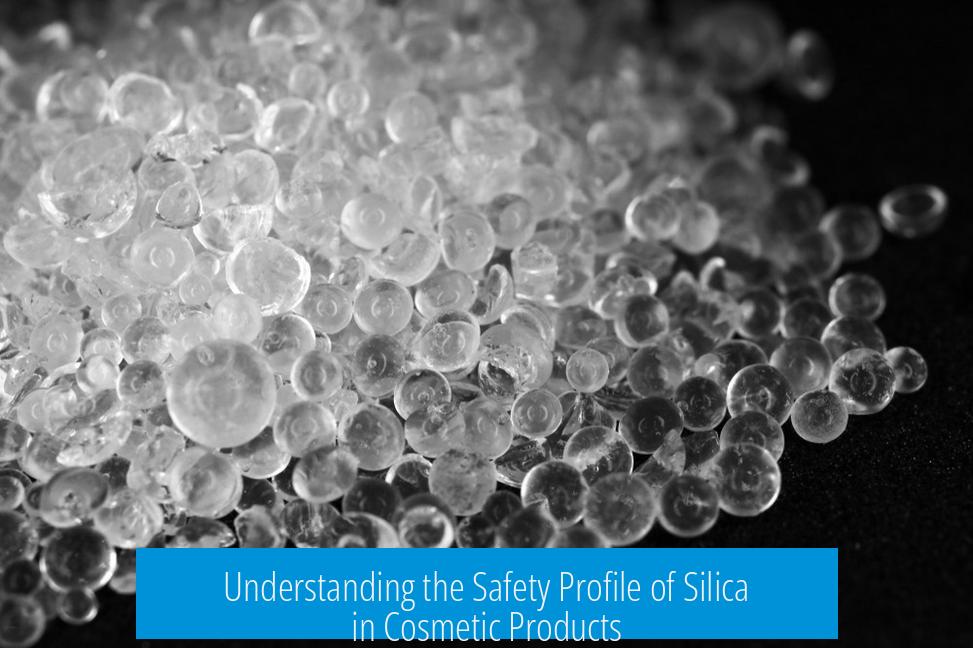Silica in Cosmetics – Safety Profile

Silica in cosmetics is generally safe when used in small, controlled amounts, especially in non-crystalline (amorphous) forms commonly found in cosmetic powders. However, safety concerns arise primarily from inhalation of crystalline silica dust, which is known to cause severe lung damage. Cosmetic-grade silica differs significantly in chemical structure and risk profile from hazardous forms like asbestos or crystalline silica dust encountered in occupational settings.
Understanding Silica and Its Forms
Silica (SiO2) is a mineral found naturally in sand, clays, and certain biological sources. However, silica in cosmetics is usually synthetic, manufactured by burning silicon tetrachloride in hydrogen furnaces. This process produces non-crystalline forms such as fumed silica and hydrated silica, widely used in cosmetic formulations.
It is essential to differentiate between the types of silica due to their differing health impacts:
- Crystalline Silica: Found naturally as quartz or in asbestos fibers; causes known respiratory diseases when inhaled as fine dust.
- Amorphous Silica: Includes fumed and hydrated silica; lacks the crystalline structure linked to lung toxicity and is regarded as safer, especially at regulated exposure levels.
- Asbestos: Comprises crystalline silicate fibers with a 6-form structure; linked strongly to asbestos-related diseases and is distinctly more hazardous than cosmetic-grade silica.
Role of Silica in Cosmetic Products

In cosmetics, silica is primarily used as an anti-caking agent in powders to prevent clumping. It improves product texture and application by absorbing oils and moisture. Hydrated silica can also function as a mild abrasive in toothpaste formulations.
Due to silica’s absorbing properties, certain skin types may experience dryness after exposure to silica-containing products. This effect is linked to its ability to draw moisture and oils away from the skin surface.
Respiratory Risks: Silica vs. Asbestos
Concerns about silica’s similarity to asbestos arise due to both being silicate minerals. However, asbestos contains fibrous crystalline silicates, presenting a higher risk for lung fibrosis and cancer upon inhalation. Cosmetic-grade silica in amorphous forms does not have such fibrous or crystalline structures.
Exposure to respirable crystalline silica dust triggers an inflammatory response in lungs. Macrophages engulf silica particles, releasing cytokines (tumor necrosis factor, interleukins) that lead to fibrosis and nodule formation. This process is largely mediated via inflammasome pathways.
In contrast, amorphous silica used in cosmetics is associated with markedly lower pulmonary toxicity. Occupational safety standards acknowledge this difference:
| Type of Silica | OSHA Occupational Exposure Limit | Health Impact |
|---|---|---|
| Crystalline Silica | 50 μg/m3 (time-weighted average) | High risk of silicosis, fibrosis, lung cancer |
| Fumed (Amorphous) Silica | 80 mg/m3 (TWA) | Low pulmonary toxicity; dust masks recommended |
Safety Considerations and Regulatory Status

The Expert Panel responsible for cosmetic ingredient safety concluded in 2022 that 24 silicate ingredients, including synthetic forms of silica, are safe when used in current cosmetic applications at recommended concentrations and formulations.
Exceptions include a lack of sufficient data regarding naturally sourced, mined silicate ingredients in products prone to incidental inhalation. This gap indicates continued caution and need for further research.
Usage and Precautions in Cosmetics
- Silica is generally safe in cosmetics when concentrations are low and formulations are designed to minimize irritancy.
- Patch testing is advisable before full product application to detect potential skin sensitivities.
- Consumers with respiratory conditions or sensitivities should avoid inhaling dust particles, especially powders containing silica.
- Cosmetic manufacturers should maintain quality assurance to prevent contamination and ensure proper particle size control.
Hydrated Silica: What Is It?
Hydrated silica is a form of amorphous silica that includes water molecules bonded within the structure. It often appears as a suspension or gel rather than a strict powder. Some confusion exists regarding whether it is simply fumed silica combined with liquids; however, hydrated silica is chemically distinct.
It is commonly used in toothpastes and some cosmetic formulations for gentle abrasiveness and texture enhancement. Unlike pure fumed silica powder, hydrated silica tends to be less dusty and less prone to airborne particle inhalation.
Environmental and Animal Safety
Silica used in cosmetics is considered environmentally safe and compatible with halal standards. It poses no significant environmental hazard when used properly. Animals such as dogs are generally safe around silica-containing products, but ingestion of large quantities could cause harm.
Summary of Key Takeaways
- Silica in cosmetics is primarily non-crystalline (amorphous) and safe at low concentrations.
- Crystalline silica, unlike cosmetic silica, causes serious lung diseases due to its fibrous structure.
- Occupational exposure limits differ greatly between crystalline and amorphous silica, reflecting safety profiles.
- Silica acts mainly as an anti-caking agent and absorbent in cosmetic products.
- Patch tests help avoid skin irritation due to silica’s oil and moisture absorption.
- Hydrated silica is a distinct, water-containing form suited for gentle abrasiveness.
- Data gaps remain for naturally sourced silicates and inhalation safety.
- Silica is environmentally safe and non-toxic to animals unless ingested in large amounts.
Silica in Cosmetics – What’s the Safety Score?
Silica in cosmetics is generally considered safe when used in its amorphous forms, such as fumed silica and hydrated silica, and at low concentrations—particularly as an anti-caking agent in powders. Yet, like any ingredient with a bit of a complicated reputation, the safety nuances deserve more than a glance. Let’s unpack this mineral mystery with clarity, skepticism, and a touch of humor.
Imagine silica as that friend you trust at a party—relaxed and harmless when calm but a bit risky if you push the boundaries. In cosmetics, we’re dealing mostly with amorphous silica, which is different from the crystalline forms linked to serious lung diseases.
Silica vs. Asbestos: The Dusty Double
Silica sometimes gets compared to asbestos, but not quite in a “cosmic twins” kind of way. Asbestos is six varieties of crystalline silicate, sneaky little fibers that can cause severe lung damage. Silica shares a molecular cousinship but comes mostly in amorphous shapes in cosmetics, which don’t behave like asbestos fibers.
Picture this: asbestos fibers sneak deep into lungs and cause cellular chaos. Crystalline silica particles do something similar—they ignite an inflammatory response, activating macrophages, releasing cytokines like tumor necrosis factor, and ultimately spurring fibrosis and nodular lesions. This nasty lung reaction is orchestrated by the NLRP3 inflammasome, a kind of immune alarm gone wild.
But here’s the kicker: The silica used in cosmetics (fumed and hydrated silica) is amorphous, lacking this dangerous crystalline structure. Occupational safety measures, like the US OSHA limit of 50 micrograms per cubic meter for crystalline silica, illustrate the risks of the crystalline form, while the amorphous kind has a much safer profile with OSHA’s Time Weighted Average (TWA) at 80 mg/m3.
Still, anyone working regularly with fumed silica often opts for dust masks. Safety first, right? Dust in your lungs is hardly a spa day.
Why Is Silica in My Powder Anyway?
If you peek at your makeup bag, you’d likely find silica in powders as the unsung hero preventing clumps. It’s an anti-caking agent that stops ingredients from sticking together like a group of drama queens. This makes application smoother and the product last longer.
But here’s a wrinkle: the cosmetics industry is loosely regulated compared to pharmaceuticals. Smaller, boutique brands might lack the resources or motivation to fully invest in rigorous Quality Assurance or Quality Control. This means you might run into batches where silica’s handled less than perfectly. Quality can vary, so consumer vigilance and research matter.
What Is Hydrated Silica? The Curious Case
Hydrated silica shows up on many labels but can feel like the “Where’s Waldo?” of cosmetic ingredients. It’s less commonly sold pure. You might wonder: Is it just fumed silica mixed with some liquid, like perfume, then added to your cream or powder?
Hydrated silica typically refers to a form of amorphous silicon dioxide that contains water molecules integrated into its structure. It’s a kind of suspension or gel form, which alters how it behaves in formulations—offering mild abrasiveness in toothpaste or texture benefits in cosmetics.
This subtle variation can affect particle size, absorbency, and application feel. Despite its widespread use, more public data on hydrated silica, especially regarding inhalation safety, remain sparse. For cautious souls, a patch test is always a wise move.
Is Silica Safe to Breathe? Don’t Try to Snort Your Powder!
Here’s a science-backed caution: inhaling fine silica dust, especially crystalline forms, is harmful. But the aerosolized silica in powders is generally less concentrated, and amorphous silica is less toxic. Still, excessive inhalation, such as from heavy dust clouds or repeated occupational exposure, can pose risks.
The respiratory system is equipped to handle common dust but struggles with tiny, engineered particles. We didn’t evolve to inhale processed nanoscopic powders produced by modern industries. So, if you regularly prod your face with powder, try to avoid creating a silica mosh pit in the air around you. Minimizing airborne dust exposure is a smart precaution.
Does Silica Dry My Skin Out? The Unseen Side Effect
Silica has absorbing properties. It soaks up moisture and oil. That’s why it works as a silky mattifier in cosmetics. However, for certain skin types—especially dry or sensitive skin—it can withdraw too much moisture, leaving skin feeling stripped or tight.
People with dry skin should pick formulations with hydrating agents alongside silica or use silica-containing products sparingly. If your skin asks for mercy, listen.
Is Silica Environmentally Friendly and Animal Safe?
Silica isn’t just safe for humans; it’s halal, environmentally friendly, and doesn’t harm critters like dogs—unless consumed in large amounts, of course. This makes it a decent ingredient for conscientious consumers who care about ethics and sustainability.
What Should Consumers Keep in Mind?
- Patch test first: Especially if you have sensitive skin or allergies.
- Don’t inhale powder intentionally: Avoid creating clouds of dust when applying silica-containing products.
- Consider brand credibility: Larger companies may have better quality control, but don’t discount the boutique brands that invest heavily in safety.
- Check product labels: If hydrated silica appears, remember its form might affect texture and safety. Research or reach out to brands if in doubt.
- Use complementary skincare: Balance silica’s absorbing effect with moisturizers to prevent dryness.
Final Thoughts
Silica in cosmetics is a tale of chemical variety and context. The amorphous forms like fumed and hydrated silica generally pose minimal safety risks when used properly and integrated thoughtfully into formulations. Their role as anti-caking agents is vital for the smooth makeup experience many appreciate.
However, the specter of crystalline silica’s toxicity is real and well studied, highlighting why product manufacturers should clearly control the form of silica and maintain high safety standards. The lack of strict regulation and oversight in the cosmetics world leaves room for imperfect practices, which means savvy consumers should stay informed.
Want to be safe and stylish? Look for reputable products, don’t make a silica dust cloud, and keep your skin’s needs front and center. By doing so, you reap the benefits of this mineral marvel without the hazards.
“It’s all about the form, the dose, and the delivery. Silica isn’t your enemy—it’s how you treat it that counts.”
What forms of silica are commonly used in cosmetics, and are they safe?
Cosmetics mostly use non-crystalline (amorphous) forms like fumed silica and hydrated silica. These forms are generally safe and differ from crystalline silica, which poses more health risks.
How does silica in cosmetics compare to asbestos in terms of safety?
Silica in cosmetics is not asbestos. Asbestos is crystalline and harmful when inhaled. Cosmetic silica is usually amorphous and safer, though inhaling large dust amounts should still be avoided.
Is inhaling silica dust from cosmetics dangerous?
Fine crystalline silica dust can cause lung damage with repeated inhalation, but cosmetic silica is mostly amorphous and used in low amounts, lowering risk. However, dusty powders might irritate lungs if inhaled frequently.
Why is hydrated silica sometimes hard to find for purchase?
Hydrated silica is often a silica suspension or gel form used in formulations. It’s not sold as a standalone consumer product, unlike fumed silica, making direct purchase uncommon.
Are there any side effects of silica on the skin?
Silica can absorb moisture and oil. For some skin types, this may cause dryness or irritation. A patch test is recommended before using products containing silica.
What regulations exist for silica exposure in workplaces?
OSHA sets exposure limits for silica dust at 50 micrograms per cubic meter. These rules apply mainly to occupational settings, not general cosmetic use.





Leave a Comment